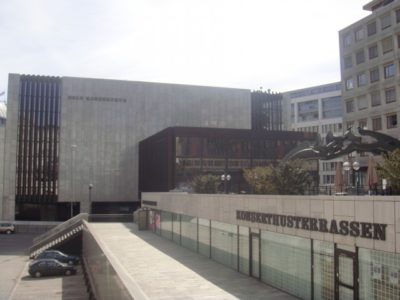Norway’s leading orchestra is celebrating its 100th anniversary this year, highlighted by special “birthday concerts” this weekend. Now the Oslo Philharmonic hopes it may get a new concert hall as the ultimate birthday present, while a new book delves into the orchestra’s often turbulent history.

Oslo Konserthus was sold out for Saturday’s concert featuring such Norwegian luminaries as soprano Lise Davidsen, pianist Leif Ove Andsnes and Truls Mørk on cello. They’ll all be led by Vasily Petrenko who’s in his last season as conductor after surviving an early storm over some controversial remarks. He’ll turn over the baton to young Klaus Mäkelä from Finland next year.
Meanwhile the orchestra has been busy playing special outdoor concerts around town since late summer and is lobbying hard for a new concert hall. Musicians and conductors have complained for years about poor accoustics inside the current concert hall, which opened in 1977, and plans have been laid for a new concert hall to be built at nearby Filipstad.
The Philharmonic’s director, Ingrid Røynesdal, has thrown her support behind the Filipstad project, and encouraged the audience at another celebratory concert last month to support the building efforts, too. She cited years of calls for a new and better building to house the orchestra that’s also won acclaim abroad. The Filipstad project is backed by hotel developers Petter Stordalen and Anders Buchardt, who have offered to finance it in return for permission to build a hotel and conference center adjacent to it on the former harbour property that’s due for redevelopment.

Others think Oslo has been building enough large cultural landmarks like the new National Museum, Munch Museum and city library, and could expand on or even recycle the Philharmonic’s present home in the heart of Oslo’s downtown Vika business district. Newspaper Aftenposten reported last month that other plans have been hatched to build a new concert hall on top of the existing Konserthus, crowning it with a glass structure that Dyrvik Architects and local real estate investor Storebrand Eiendom think would be more environmentally friendly than an entirely new building.
“A new concert hall (literally on top of the old) could open up new opportunities, and be a modern and well-functioning venue for around 2,000 with optimal accoustics,” writes Dyrvik on its website. The entire building, which already features smaller venues, “could become a vital musicians’ house of sorts.”
The project quickly won support from another leading Norwegian architect who also advises the city planning agency, Peter Butenschøn. “If there’s any building in Oslo that’s suitable for an addition, it must be this one,” he wrote in Aftenposten earlier this month.

Røynesdal and the leader of the Oslo Philharmonic’s board, the former head of Norway’s powerful national employers’ organization NHO Kristin Skogen Lund, are skeptical and still want a new building. They note that the Philharmonic has put up with a concert hall that was a compromise location from its beginning more than 40 years ago. Now they’ve been offered a “suitable” site at Filipstad that would be a “realistic, manageable project.” The head of Oslo’s city agency in charge of historic preservation (Byantikvaren) is also skeptical towards modifying the existing Konserthuset.
As the debate over a new home for the Philharmonic goes on, Røynesdal and Lars Petter Hagen, project leader for the orchestra’s jubilee, have stressed how important a symphony concert still is in modern and hectic times, when many find themselves mostly wearing headphones and staring at computer or telephone screens. Røynesdal and Hagen promoted what the called “active listening” in a collective meeting place where phones and other interruptive devices are turned off for a while.
“We believe orchestra concerts have never been so important … perhaps as a contrast to what fills our lives otherwise,” they wrote in Aftenposten last month. The Oslo Philharmonic’s 100th birthday celebrations, they wrote, would reflect both its past and present, along with how classic music has been and is important for the public.
Controversial history
A new book commissioned to mark the Oslo Philharmonic Orchestra’s history reveals that it hasn’t always been harmonious. Its founders, according to journalist and author Alfred Fidjestøl, wanted to establish an orchestra that could function as a conciliatory force to promote fraternity and help heal the wounds of World War I. Instead, the orchestra has allowed itself to be influenced by ideological, national and political conflicts, writes Fidjestøl, and was used as a tool by those who had power at the time.
That included Nazi German occupiers during World War II, who arguably misused the orchestra that kept playing with German soloists and at events that hailed Norway’s Nazi occupiers. In his book entitled Lyden av Oslo (The Sound of Oslo), Fidjestol writes about the orchestra’s German Jewish violinist Ernst Glaser who ultimately had to flee to Sweden to avoid deportation. “Afterwards the orchestra continued to play for those who wanted to kill Glaser,” Fidjestol told newspaper Dagsavisen last week when the book was released. “That says something about the human drama that played out.”
The orchestra has also been used as part of Norway’s “nation building” efforts, and from 1979, the orchestra had a Soviet conductor “in a NATO country during the Cold War!” Fidjestol exclaimed. The orchestra has at the very least adapted to changing times and today the Oslo Philharmonic is regarded as one of Europe’s leading orchestras, which sets off on international concert tours every year. It’s clearly wanted to just keep the music playing, which it will surely do throughout its jubilee year.
newsinenglish.no/Nina Berglund

